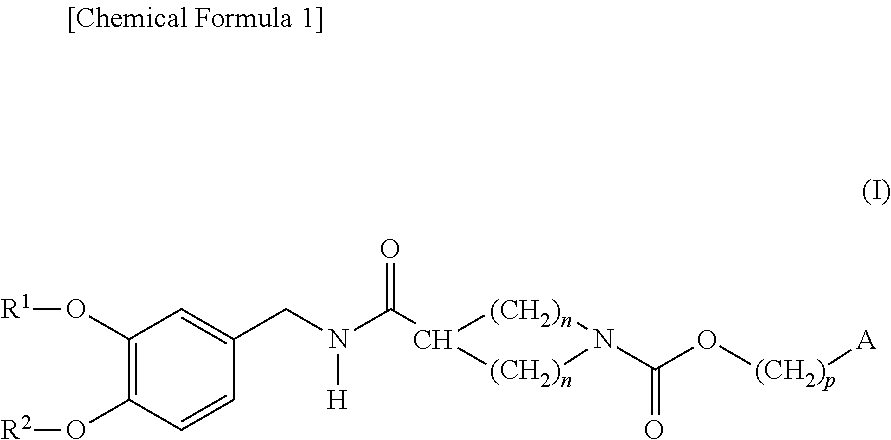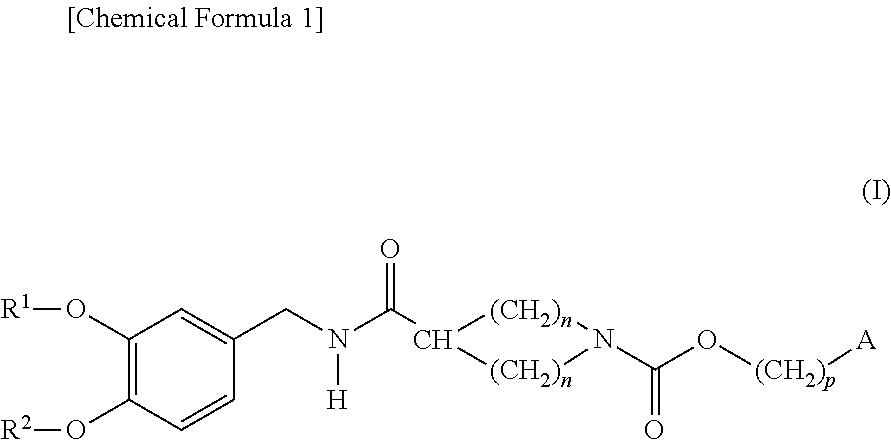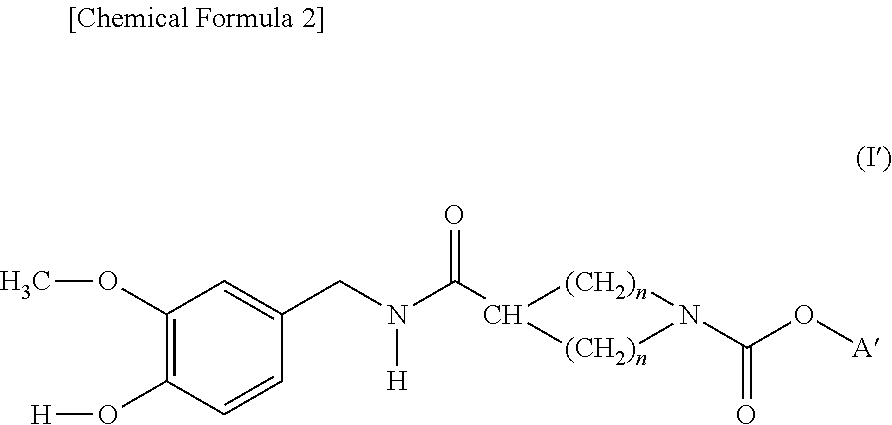Cyclic amine-1-carboxylic acid ester derivative and pharmaceutical composition containing the same
a technology of cyclic amine and ester, which is applied in the direction of drug compositions, immunological disorders, metabolism disorders, etc., can solve the problems of ineffective nsaids, high pungency, and ineffective nsaids, and achieves low pungency and strong analgesic
- Summary
- Abstract
- Description
- Claims
- Application Information
AI Technical Summary
Benefits of technology
Problems solved by technology
Method used
Image
Examples
example 1
Preparation of cis-4-ethylcyclohexyl 4-(4-hydroxy-3-methoxybenzylcarbamoyl)-piperidine-1-carboxylate
[0217]
[0218](1) 1-Ethyl-3-(3-dimethylaminopropyl)carbodiimide hydrochloride (12.5 g) was added to a mixture of 4-benzyloxy-3-methoxy benzylamine hydrochloride (14.0 g), 1-(t-butoxycarbonyl)-piperidine-4-carboxylic acid (11.5 g), triethylamine (14.0 ml) and methylene chloride (300 ml). After stirring the reaction mixture at room temperature for 20 hours, the mixture was washed with saturated ammonium chloride aqueous solution and then saturated brine, the organic layer was dried over sodium sulfate and the solvent was evaporated under reduced pressure. The residue was purified by silica gel chromatography (elution solvent: hexane / ethyl acetate=100 / 0 to 0 / 100 gradient) to obtain 16.3 g of t-butyl-4-(4-benzyloxy-3-methoxybenzylcarbamoyl)-piperidine-1-carboxylate.
[0219](2) The product (16.3 g) of the above (1) was dissolved in ethyl acetate (270 ml) and 4 mol / l hydrogen chloride / ethyl ace...
examples 2-12
[0224]Using various substituted cyclohexanols instead of the cis-4-ethylcyclohexanol in Example 1, the compounds shown in Table 1 and Table 2 were obtained by reacting and treating in the same manner as in Example 1.
TABLE 1ExampleStructural formula1H-NMR (CDCl3, δ) (Melting point)(m.p.) (XRD)Example 20.87 (3H, t), 0.90-1.36 (7H, m), 1.60-1.88 (6H, m), 1.92-2.05 (2H, m), 2.18-2.30 (1H, m), 2.66-2.82 (2H, m), 3.88 (3H, s), 4.08-4.25 (2H, m), 4.35 (2H, d), 4.48-4.60 (1H, m), 5.59 (1H, s), 5.66 (1H, brs), 6.72 (1H, dd), 6.76 (1H, d), 6.86 (1H, d). ((m.p. 1 20° C.) (2 θ = 5.2, 7.5, 8.7, 14.9, 19.1° ))*Example 30.91 (3H, d), 1.11-1.29 (2H, m), 1.35-1.75 (7H, m), 137-1.91 (4H, m), 2.19-2.31 (1H, m), 2.68-2.87 (2H, m). 3.88 (3H, s), 4.10-4.29 (2H, m), 4.36 (2H, d), 4.86-4.93 (1H, m), 5.59 (1H, s), 5.87 (1H, brs), 6.76 (1H, dd), 6.79 (1H, d), 6.87 (1H, d).Example 40.88 (3H, d), 0.94-1.10 (2H, m), 1.21-1.41 (3H, m), 1.60-1.76 (4H, m), 1.77-2.01 (4H, m), 2.18-2.30 (1H, m), 2.68-2.82 (2H, m), 3...
example 13
Preparation of cis-2-ethylcyclohexyl 4-(4-hydroxy-3-methoxybenzylcarbamoyl)-piperidine-1-carboxylate
[0225]
[0226]Using 2-ethylcyclohexanol instead of the cis-4-ethylcyclohexanol in Example 1, the reaction and treatment were carried out in the same manner as in Example 1. Then, the cis isomer was separated and formed by silica gel column chromatography (elution solvent: hexane / ethyl acetate=100 / 0 to 0 / 100 gradient) to obtain an intended product.
[0227]1H-NMR (CDCl3, δ): 0.88 (3H, t), 1.15-1.84 (11H, m), 1.85-1.98 (4H, m), 2.21-2.34 (1H, m), 2.68-2.94 (2H, m), 3.88 (3H, s), 4.11-4.30 (2H, m), 4.36 (2H, d), 4.89-4.97 (1H, m), 5.59 (1H, s), 5.66 (1H, brs), 6.75 (1H, dd), 6.78 (1H, d), 6.87 (1H, d).
PUM
| Property | Measurement | Unit |
|---|---|---|
| temperature | aaaaa | aaaaa |
| temperature | aaaaa | aaaaa |
| temperature | aaaaa | aaaaa |
Abstract
Description
Claims
Application Information
 Login to View More
Login to View More - R&D
- Intellectual Property
- Life Sciences
- Materials
- Tech Scout
- Unparalleled Data Quality
- Higher Quality Content
- 60% Fewer Hallucinations
Browse by: Latest US Patents, China's latest patents, Technical Efficacy Thesaurus, Application Domain, Technology Topic, Popular Technical Reports.
© 2025 PatSnap. All rights reserved.Legal|Privacy policy|Modern Slavery Act Transparency Statement|Sitemap|About US| Contact US: help@patsnap.com



